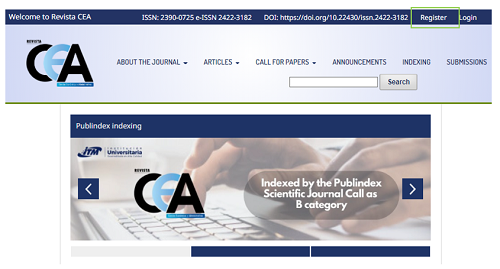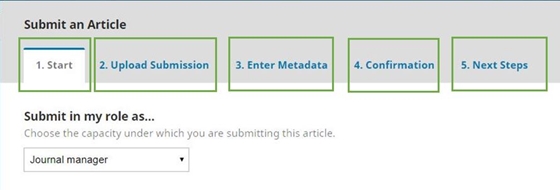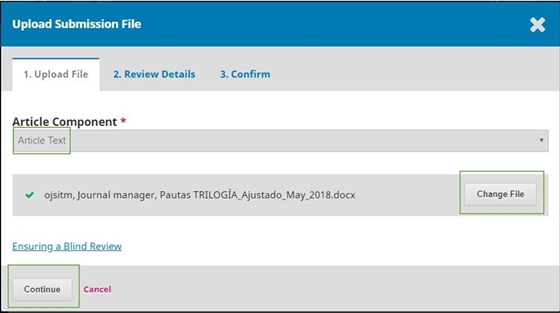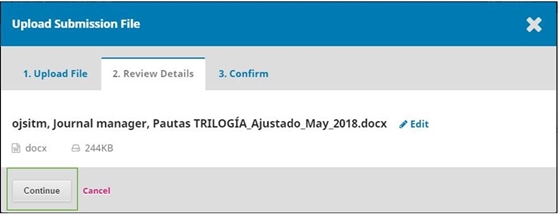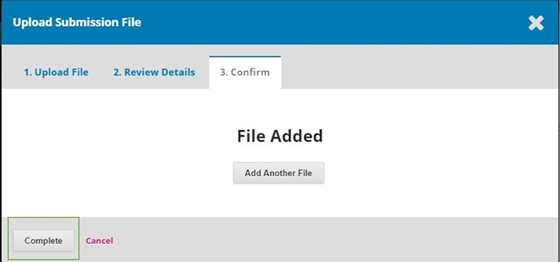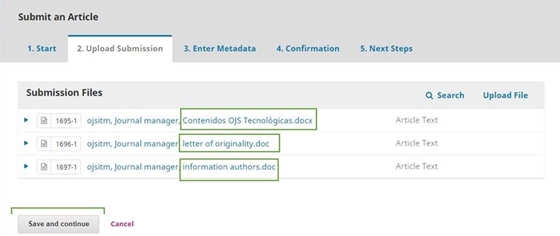For Authors
Submission Guidelines
To start sending your article please verify that your manuscript complies with the requirements described in the Guide to prepare a submission section.
Keep in mind the following instructions to ensure the successful delivery of your manuscript:
To guarantee the delivery of the articles successfully, follow the following instructions step by step:
1. Click on «Register» at the top of the screen.
2. Fill in the form and finally click on «Register»
3. Once identified in the system as an author, click on the «Proposals» option and then on «New submission».
4. Follow the instructions provided by the system until completing the five steps.
5. To load the article, select the option «Text of the article» and attach the text via the «Upload file» option and click on «Continue».
6. On the next tab «2. Metadata », click on «Completed», then on the tab «3. Confirm », click on «Completed».
7. When you have finished attaching the article and the required formats, click on «Completed».
8. Check the information and click on «Save and continue»
9. When you have finished all the steps and fill in the required information, click on the «Finish sending» button to see the confirmation message.
Article preparation guide
We suggest that the authors review the complete document template for submissions, where you will find in detail all the recommendations for the construction of your text:
Before starting the submission process please verify that your manuscript meets the following requirements. Items that do not comply with these instructions will be returned to the author.
 |
|
I. SHIPPING REQUIREMENTS
1. The content of the manuscript is original and unpublished, has not been published in any format and is not simultaneously postulated in other national or international publications.
2. The manuscript corresponds to one of the types of article published by the Revista CEA journal, which are described later on this page.
3. The manuscript corresponds to one of the topics of interest declared by the journal, which are described at the end of this page.
4. The manuscript is written in MS Word format, according to the criteria of style and format and the other orientations indicated in the template for submissions.
5. The maximum length of the articles will be 20 pages written in one column following the criteria and format of the journal.
6. For each of the authors, their contact information and their institutional affiliation have been identified and an author identifier (ORCID, ResearcherID, ScopusID, other)
7. The title is written both in the original language and in English, as far as possible it does not contain more than twelve words.
8. It has a summary in both the original language and English, with an extension between 200 and 300 words, and reflects the most important aspects of the work.
9. It has at least four key words and maximum six, in Spanish and English, which describe the most important aspects of the work.
10. The body of the document has the structure and formality required for the type of article submitted. In any case, it includes introduction, development (according to type of article), discussion and conclusions.
11. The references are complete and updated, preferably from the last 5 years, and have been prepared in accordance with APA standards, using a reference manager. All of them are cited in the manuscript, and web addresses or the DOI have been added for references where applicable.
12. Do not include Bibliographic reference that you have not cited in the manuscript.
13. All the figures and tables are referenced in the text, in the corresponding site and not at the end of the article, they can be edited and are in 300 dpi resolution.
II. TYPES OF ITEMS
Revista CEA Journal receives proposals for academic articles that fall into the following categories:
Research article: document that presents in a detailed way original research results. The document must clearly show the problem being treated and the previous works recently published in the scientific literature, it must also describe in a rigorous and complete manner the proposed methods and experimental results that show the contribution of work in one of the branches of economics and administration sciences and present a discussion of the advantages and disadvantages of these, in contrast to the state of the art, and finally, a section of conclusions that respond to the objectives and are generated from the content of the manuscript.
Review article: document resulting from a research where the results of published research or not, on a field in science or technology, are analyzed, systematized and integrated, in order to account for progress and development trends. It is characterized by presenting a careful bibliographic review of at least 50 references.
Reflection article: document that presents research results from an analytical, interpretative or critical perspective of the author, on a specific topic, using original scientific sources.
III. THEMES OF INTEREST FOR PUBLICATION IN THE REVISTA CEA JOURNAL
The articles should be focused on the area of economics and business, integrated by the fields of administration, economics, technology and innovation management, marketing, human talent management, quality, business history, econometrics, finance, accounting, and decision sciences.
The Revista CEA Journal has a permanent call process for the reception of articles written in Spanish or English. The journal only receives original and unpublished works, that is, those that have not been previously published, partially or totally, in any printed, electronic or digital medium, and that are not being simultaneously considered for publication in any other medium. Interested authors should send their articles in Microsoft Word word processor format through this platform, following the instructions given in General guidelines for a submissions.
The authors of the articles must grant the Revista CEA Jounal ownership of their copyright, so that their article can be reproduced, published and disclosed in any form or medium. The purposes are exclusively scientific for dissemination and non-profit. In no case, this process affects the moral rights and intellectual property that is proper to the author
It is required that the authors present the articles according to the criteria of style and format, following the guidelines given below and making use of the template that can be downloaded on the website of the journal. Only articles that conform to the formal conditions of presentation are evaluated.
Editorial Workflow

Once the article is received in the Revista CEA Journal, the author will be answered and included in the editorial process, which will be developed in the following phases, the fulfillment of each stage is a prerequisite to continue the process:
Preliminary evaluation
In this stage, the structure of the article and the fulfillment of the application requirements will be reviewed (listed in the section Preparation of article guide). Likewise, strict compliance with the ethics policies and good practices defined by the journal will be verified, in which it is established that the editors will NOT allow breaches of professional ethical codes, such as: plagiarism, double publication, fraudulent use of data and false statements of authorship, among others; This process includes the verification of the originality of the manuscript through a software for the identification of coincidences. In case of identifying indications about infractions of these codes of ethics, the procedure established in the COPE Flow diagrams will be followed to resolve cases of suspected bad practices (see here). The estimated time for this process is 48 to 72 hours.
Once the review is completed, the author will be notified about the news and decisions made with his manuscript, which may be: rejection for non-compliance with the requirements, request for modifications to correct necessary requirements before proceeding with the process or continuation with the editorial process. Minor non-conformities will be informed in later stages, so that they are corrected before the publication of the manuscript, in case it is accepted.
Editorial evaluation
The editorial evaluator must critically and constructively analyze the content of the manuscript and declare the quality of the manuscript. Their observations and recommendations are very important for the editorial work of the journal because based on this, the editor will determine if the manuscript can continue with the external academic evaluation process. In case the manuscript does not pass the editorial evaluation, the observations will serve the authors to identify opportunities for improvement, for future applications.
Academic evaluation by peers
The journal's evaluation policy is scientific double blind arbitration, in which the identity of the authors and evaluators is unknown to both parties. The article will be sent minimally to two external academic pairs, chosen based on the following criteria:
- Academic training of master's or doctorate in the subject area.
- Scientific publications in the area of interest in the last 5 years
- Have an H index of 5 or higher
Have a different institutional affiliation to that of the publishing institution - Have a preferably international institutional affiliation
- Have an institutional affiliation different from that of the authors of the manuscript
- Declare no conflict of interest with the publishing institution, the journal or any of its members (editors, authors, members of the editorial and scientific committee)
The communication with the evaluating peers will be done through the OJS, where they will issue a concept about the academic quality of the content of the manuscript, rigor in the theoretical and methodological treatment and about the novelty or advancement of the author's contribution to the field of knowledge. The evaluators have a maximum of 30 business days to issue their concept in the evaluation format provided by Revista CEA, as well as to declare no conflicts of interest and to know the specific rules of ethics in research, confidentiality and plagiarism.
Possible results: according to the critical assessment of the academic quality and scientific rigor of the content, the evaluation process must contain one of the following results:
- The article may be published subject to minor modifications.
- The article can be published subject to major modifications.
- The article should not be published for the reasons indicated in this review.
Cases of controversy: in cases of controversy, either because the concepts of the peers are opposed to each other, or because the author does not agree with the opinion, an additional evaluator will be appointed. If the controversy persists, it will be the editor-in-chief, with the possible help of the Editorial and Scientific Committee, who issues a qualified concept and makes the final publication decision, after carefully analyzing the peer assessments assigned to the manuscript.
Confidentiality: The Instituto Tecnológico Metropolitano, in its relations with third parties, will observe the principles of good faith and respect for intellectual property. Due to the above and to guarantee the impartiality of the academic evaluation of this article, the editing of the Revista CEA journal, reserves the name of the author of the work. The name of the evaluators is also confidential and at no time will the authors be announced. The confidentiality of this document implies that none of its parts can be used for a purpose other than the one established, and you cannot share them with anyone without the permission of the editor.
Publication decision: according to the report of the evaluators and the additional observations arranged by the Editorial Committee, the author will be informed of the decision of publication or not of the article and the necessary adjustments will be requested based on the results of the evaluation. its publication. The corrected version will be revised again to verify that all required changes have been included in the article.
Production
Once the article is approved, it enters the production process in which a series of interventions are developed for its final edition, in order to ensure the quality and presentation of the article to be published.
Text revision process. At this stage, the text will be adjusted based on APA international standards and parameters regarding the citation and referential part. Likewise, an orthotypographic, semantic and syntactic revision will be made. At this stage, clarifications may be requested on concepts and ideas presented, suggestions may be made to improve the wording of the text, as well as correction of tables, figures and quotations as necessary, so that the text has cohesion and coherence.
In addition, the metadata will be reviewed for completeness and functionality, according to the parameters of the journal, as well as its translation into English, reviewing grammar and correct use of words.
Design and layout. The article undergoes a review and formatting, finalizing details of presentation and compliance with form requirements for publication, taking into account the journal's own aspects and following good editorial practices. The last version of the article will be reviewed again by the editor and the respective authors, for final corrections. The author will be asked for final approval of the article for publication.
Markup. Finally, the article will be processed for publication in formats other than PDF, in order to give visibility to the article by making it available for viewing in the formats that the journal considers appropriate and that are available.
Publication
The edition of the journal will be published free of charge in electronic format on the journal's website. This is the final stage of the editorial process. The procedure for the publication of the article and the necessary data is developed, as required in each case. After its publication, a metadata quality review will be made to finally activate the DOI identifier of each article. A satisfaction survey is available to the authors for the feedback of the editorial processing carried out by the journal.
Editorial processing times:
The entire review process, from the time of manuscript submission through OJS to the completion of external peer reviews, involves an average time of 6-8 months.
In any case, it is stated that the times are approximate since the editorial process can be variable and depends on many factors, such as availability and response time of external peers, time taken by the authors in the corrections stage, contractual inconveniences, among others.
How to spread your published article
To encourage further views and citations, the authors should also promote the dissemination of their articles. The following are some of the actions you may consider:
1. Dissemination in social and academic networks and personal pages: Some free platforms such as Mendeley, ResearchGate, Academia, Google Scholar, and personal blogs enable you to create a profile, list your publications, and make them more visible in search engines, which favors a more effective dissemination of the article.
2. Learning resource and reference: Use your article as a learning resource in the syllabi of the courses you teach, as well as in degree projects you advise in order to promote its citation. You may also invite your (national and international) colleagues to use the paper in their articles and courses.
3. Content dissemination: Write a short description (no longer than two lines of text) to share by email, social networks, blogs, and web pages, inviting your colleagues and acquaintances to download and cite your work. Include the link or DOI of your article.
4. Related academic activities: If you participate in congresses, presentations, or discussions, mention your article and the free download option in this journal’s homepage.
5. Add the article to your ORCID profile: Add the data of the published article to your profile, keep the information about your academic production up to date, and make your profile visible, so that if readers wish to learn more about your works they can be redirected from your profile. https://orcid.org/
6. Publication in your institutional repository: If your organization has an institutional repository, upload the final version of your article to improve its visibility in search engines.

